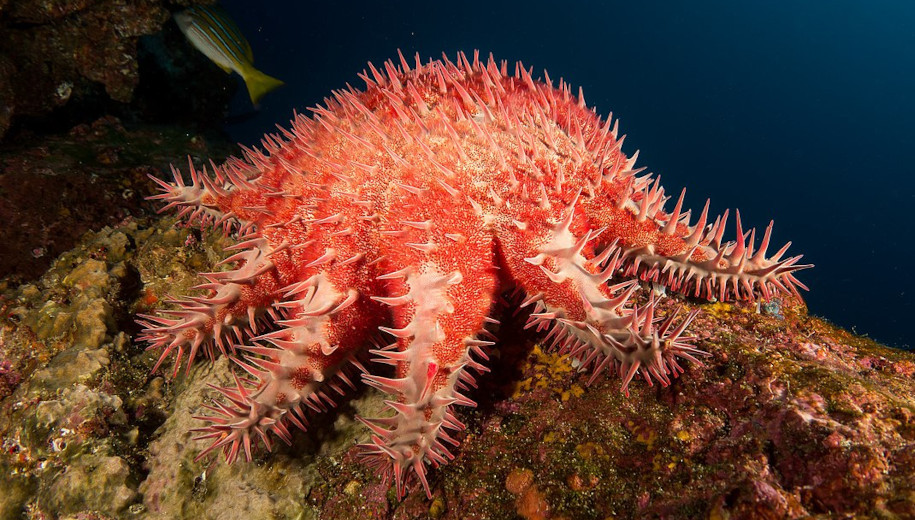13/11/20
Habits of coral-eating starfish mapped for easy culling

By: Claudia Caruana
Send to a friend
The details you provide on this page will not be used to send unsolicited email, and will not be sold to a 3rd party. See privacy policy.
[NEW YORK] Findings by Australian researchers that crown-of-thorns starfish (CoTS) feed on coral polyps at night and rest from dawn until afternoons offer a way to save coral reefs from destruction by the destructive, predatory marine species.
“The crown-of-thorns starfish essentially follows the ‘teenager model’ of behaviour: it parties all night and sleeps in till midday, and only finds its way home if there is a well-stocked larder of their favourite coral prey,” says Scott Ling, senior lecturer in marine biology, ecology and biodiversity centre, Institute for Marine and Antarctic Studies, University of Tasmania.
“The crown-of-thorns starfish essentially follows the ‘teenager model’ of behaviour: it parties all night and sleeps in till midday, and only finds its way home if there is a well-stocked larder of their favourite coral prey”
Scott Ling, University of Tasmania
For their research, reported this month (November) in Proceedings of the Royal Society B, Ling and his team relied on time-delayed, digital underwater photography.
The starfish (Acanthaster planci), which devour coral polyps, range in size from 25—35 centimetres in diameter and can be as long as 80 centimetres. They have poisonous spines and may be difficult to spot on a reef.
Ling’s interest in night and day cycles of crown-of-thorns starfish began with his time-lapse monitoring of sea urchins as they overgrazed kelp beds in southern Australia. “I was interested in using the same time-lapse approach to better understand how crown-of-thorns starfish eat corals.”
Ling’s team tracked the movement of the starfish in the northern and southern Great Barrier during a large outbreak in 2015. In the absence of their preferred Acropora coral prey, starfish were typically homeless and instead roamed up to 20 metres a day.
“The management implications of the time-lapse monitoring study are that movement of the starfish increases in the afternoon and into the evening, and so this is the time when divers are likely to encounter more starfish visible on the reef surface — which can then be targeted by divers working for crown-of-thorns culling programmes,” says Ling.

Ling and his colleagues also learned that the behaviour of the starfish changed depending on its local reef environment.
“In the absence of preferred coral prey nearby, the starfish moved away from the field-of-view of the time-lapse cameras. Where the starfish was associated with nearby preferred coral, they typically showed reduced movement. Ultimately if they found a shelter near to a food source, they demonstrated homing behaviour where they would sequentially forage on coral (typically at night) before returning to a home shelter. This type of homing behaviour was previously undescribed for the CoTS,” Ling says.
Based on their findings, Ling says that to protect healthy reefs with high cover of corals, the team would recommend putting more diving effort into searching and culling starfish from midday until early evening. “The starfish appear to sleep in and will be harder to find on the reef before about midday.”
The starfish’s behaviour might be similar in other regions of the South Pacific, Ling believes. “We see the same types of scarring patterns on corals left by CoTS following consumption of corals across the South Pacific, so we consider it likely that similar foraging movements and homing behaviours occur on reef systems beyond the Great Barrier Reef,” says Ling.
“We suspect that the lesson of afternoon emergence of ‘homing’ starfish on healthy coral reefs also likely applies elsewhere, and thus the applied outcome of targeting culling dives in this period is also likely to apply elsewhere,” he says.
Caballes notes that although limited in terms of spatial scale, the study highlights the strong, site fidelity among individual crown-of-thorns starfish and shows that the availability of preferred coral prey significantly influences movement and foraging behaviour.
“Detectability of COTs is crucial in the success of culling programs. The current study can be extended to investigate whether CoTS can move between reefs after localised depletion of coral prey and whether starvation makes CoTS more susceptible to disease,” Caballes stresses.
This piece was produced by SciDev.Net’s Asia & Pacific desk.













